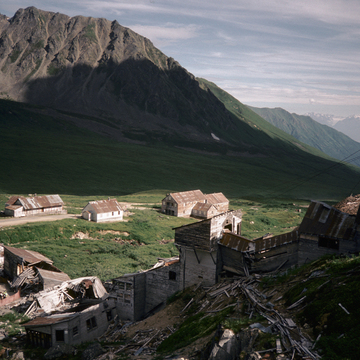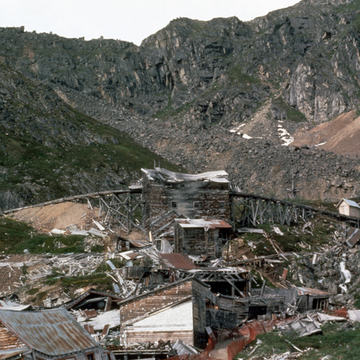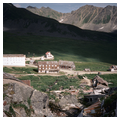Located on the barren east face of Granite Mountain in Talkeetna Range, well above the tree line, the buildings of Independence Mine cling to the rugged terrain in a vertical alignment that uses gravity to assist production. Now operated as a state park, Independence Mine is a fine example of a hard-rock gold
Placer gold was found in the Willow Creek district as early as 1897. The first hard-rock gold claim was filed in 1906, and by 1909, there was a minor stampede to the Willow Creek district. Of the thirty-eight hard-rock gold mines and prospects, fifteen produced gold. One of those is Independence.
In 1934 Alaska-Pacific Mines began to buy up claims, and in 1938, when its name was changed to Alaska-Pacific Consolidated Mining Company, the claims consisted of two primary holdings: the Independence Mine and the Alaska Free Gold Mine, both in the Fishhook Creek valley. Between 1937 and 1940 the company employed on average two hundred men and milled more than seventy thousand tons of ore here, averaging thirty-eight dollars of gold per ton. The mine was forced to close in 1943 by order of the War Production Board, and never regained its former productivity.
Active mining took place in the mountains, above the mill site. Aerial trams took equipment up to the mine, and brought ore down to the cluster of buildings below. Because of the heavy snowfall, most of the buildings were connected by covered walkways. The buildings were simple in design, wood-framed with beveled siding, with corrugated-metal gable roofs. All of the buildings, save one, were painted silver with red trim.
Besides the buildings mentioned below, buildings still standing at the site include administrative offices; a warehouse-bunkhouse; plumbing, sheet metal, and electrical shops; an apartment house for the mine manager, mine foreman, mill foreman, and shop foreman; and various storage buildings. Miners with families were encouraged to build their own houses, which they did at a nearby site called “Boom Town.” Although twenty-two houses were reported here in 1942, none has survived intact.
All of the surviving buildings at the mine site were constructed between 1936 and 1941. The heavy snowfall has taken its toll on the buildings; many of them are severely deteriorated and have caved in. Yet by their placement on the landscape and their general form, an understanding of this hard-rock gold mine can be gained.














